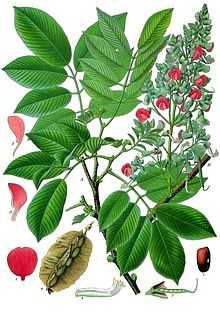Piscidia piscipula
| Florida Fishpoison Tree | |
|---|---|
 | |
| Scientific classification | |
| Kingdom: | Plantae |
| (unranked): | Angiosperms |
| (unranked): | Eudicots |
| (unranked): | Rosids |
| Order: | Fabales |
| Family: | Fabaceae |
| Genus: | Piscidia |
| Species: | P. piscipula |
| Binomial name | |
| Piscidia piscipula[1] (L.) Sarg. | |
| Synonyms | |
|
Piscidia erythrina L. | |
Piscidia piscipula, commonly named Florida fishpoison tree, Jamaican dogwood or Fishfuddle, is a medium-sized, deciduous, tropical tree endemic to southern Florida, the Florida Keys, Texas, Caribbean, and Latin America.[2] Native Americans of the West Indies discovered extracts from the tree could sedate fish, allowing them to be caught by hand.[2] This practice led to the tree's common names—fishpoison and fishfuddle. The tree has medicinal value as an analgesic and sedative.[3]
The generic name is Latin for "fish killer", and the specific epithet is Latin for "little fish".[4]
Habitat
The Florida fishpoison tree grows in coastal zones. It prefers well-drained sandy soils, with a top layer of humus.[5] The tree has some tolerance to short-term storm surges of brackish water or seawater. Although it grows in coastal conditions, the tree is usually protected from direct salt spray by adjoining vegetation. Established trees are highly tolerant of drought. Its sensitivity to the cold limits Florida fishpoison tree to areas no colder than plant hardiness zone11.
Description
Size: The Florida fishpoison tree attains medium size with heights of 12 to 15 m and bole diameters of 46 to 118 cm. An irregular, open crown develops with stout, erect branches.[2]
Foliage: Its deciduous leaves (9 to 23 cm long) are alternate and pinnately compound. Five to 11 leaflets (each 4 to 8 cm long) are present in an opposite arrangement. Leaflets are dark green above and distinctly paler grayish-green below with pubescence.[6]
Flowers/Fruit: The white flowers are tinged with red or pink.[2] They appear in pea-like clusters in May and are attractive to bees. Trees will potentially bloom when about 4 m tall and 4 years old. Flowers develop into a light brown, bean-like pod (8 to 10 cm long) with four papery wings. Ripening in July and August, the pods contain red-brown seeds with oval shapes.
Bark: Stem bark is thin and olive gray in color with irregular dark patches and many smaller scales.[2] The bark has an unpleasant odor and a distinctly acrid and bitter taste, causing a burning sensation in the mouth.
Propagation: After removal from the ripe pod, seeds will germinate in 8 to 10 days when sown about 6 mm deep in moist soil.[4] Until seedlings become well established, they should be fertilized and watered. Cuttings placed in moist soil quickly sprout roots. In fact, rooting has been observed to occur so readily that posts made from fresh timber occasionally take root unintentionally.
Ecology
Larval host: Florida fishpoison tree is a larval host plant for several butterfly species including: the native cassius blue butterfly (Leptotes cassius) and hammock skipper (Polygonus leo) and the introduced fulvous hairstreak (Electrostrymon angelia).[5]
Uses
Cultivation
Ornamental: In areas with a suitable climate and soils, Florida fishpoison tree makes a hardy, medium-sized shade tree with attractive seasonal flowers. It is ideal for yards and along fence rows.[4] The species is shade intolerant, requiring full sunlight for maximum development.
Lumber
Wood: The yellow-brown wood of fishpoison tree is resistant to decay, making its timber suitable for outdoor usage, such as boat building, fence posts, and poles.[2] The dense, tight-grained wood is also used as a fuel, to make charcoal, and as a good carving material.
Fishing
Fish poison: Indigenous peoples all over the world used local poisonous plants to aid in catching fish, and because of this many plants bear common names descriptive of this use.[7] Within its natural range, Native Americans used an extract from the bark, roots, twigs, and leaves of Florida fishpoison tree to sedate fish, making them easier to catch. A number of chemicals are present in the tree's tissues that are toxic to fish, the principal one being the well-known Rotenone.[4]
Herbal medicine
Piscidia piscipula can be toxic and should only be used under direction of a doctor.[8] It has been used in herbal medicine for treating nervous conditions and pain. Recent scientific studies in animals suggest that bark extracts may have potential for their anti-inflammatory, sedative, and anti-spasmodic effects.[8]
See also
References
- ↑ USDA Natural Resources Conservation Service. Plants Database. Piscidia piscipula (L.) Sarg. Florida fishpoison tree.
- ↑ 2.0 2.1 2.2 2.3 2.4 2.5 University of Florida. School of Forest Resources and Conservation. Florida Forest Trees: Fishpoison tree (Piscidia piscipula).
- ↑ Auxence, Elena G. 1953. A pharmacognostic study of Piscidia erythrina. Economic Botany 7(3): 270-284
- ↑ 4.0 4.1 4.2 4.3 Nellis, David N. 1994. Seashore plants of South Florida and the Caribbean: A guide to identification and propagation of xeriscape plants. Pineapple Press. 160 p.
- ↑ 5.0 5.1 Institute for Regional Conservation: Jamaica-dogwood
- ↑ Nelson, Gill. 1994. Trees of Florida: a reference and field guide. Pineapple Press. 338 p.
- ↑ Kritzon, Chuck. Fishing with poisons. Primitive Ways.
- ↑ 8.0 8.1 University of Maryland Medical Center. Jamaica dogwood.
Further Reading
Cuevas-Glory, Luis; Ortiz-Vázquez, Elizabeth; Pino, Jorge; Sauri-Duch, Enrique (July 2012). "Floral classification of Yucatan Peninsula honeys by PCA & HS-SPME/GC-MS of volatile compounds". International Journal of Food Science & Technology 47 (7): 1378-1383. doi:10.1111/j.1365-2621.2012.02983.x.
Estrada-Medina, Hector; Santiago, Louis S.; Grahama, Robert C.; Allen, Micheal F.; Jimenez-Osornio, Juan Jose (October 2013). "Source water, phenology and growth of two tropical dry forest tree species growing on shallow karst soils". Trees (Berlin) 27 (5): 1297–1305. doi:10.1007/s00468-013-0878-9.
Tamayo-Chim, Manuela; Reyes-García, Casandra; Orellana, Roger (21 January 2012). "A combination of forage species with different responses to drought can increase year-round productivity in seasonally dry silvopastoral systems". Agroforestry Systems 84 (2): 297 Extra |pages= or |at= (help). doi:10.1007/s10457-011-9470-8.